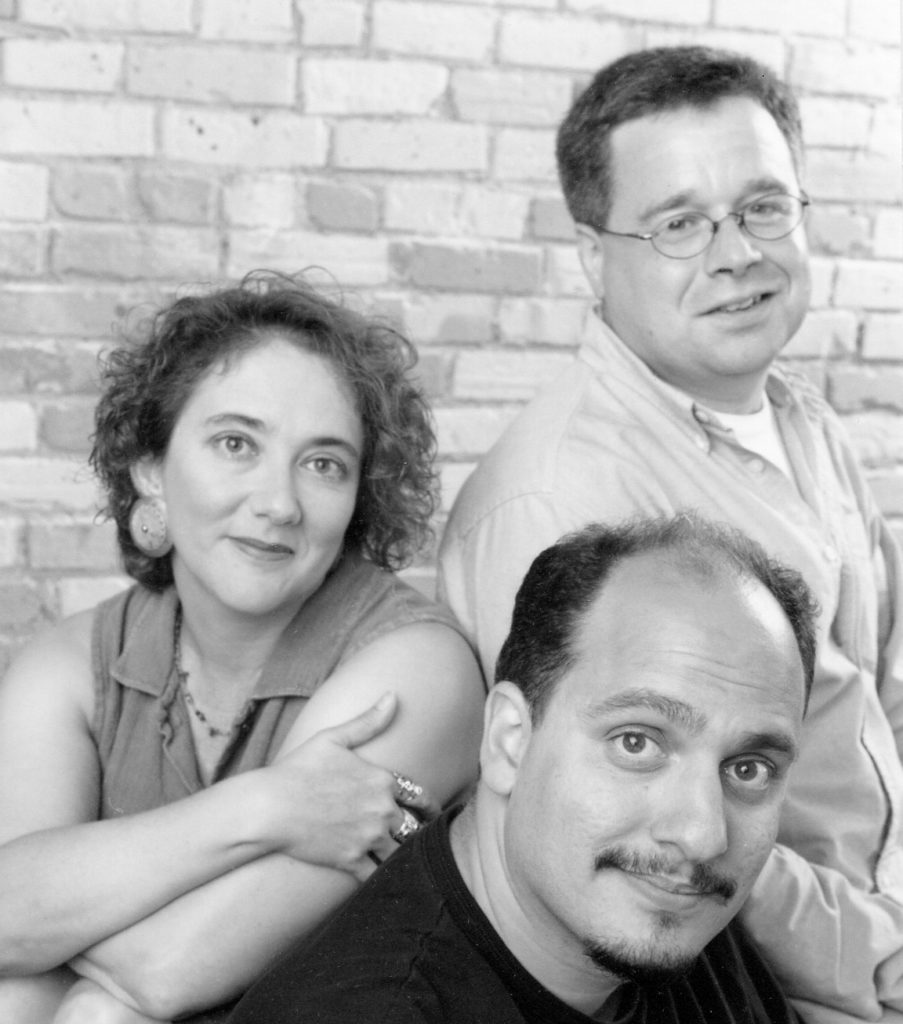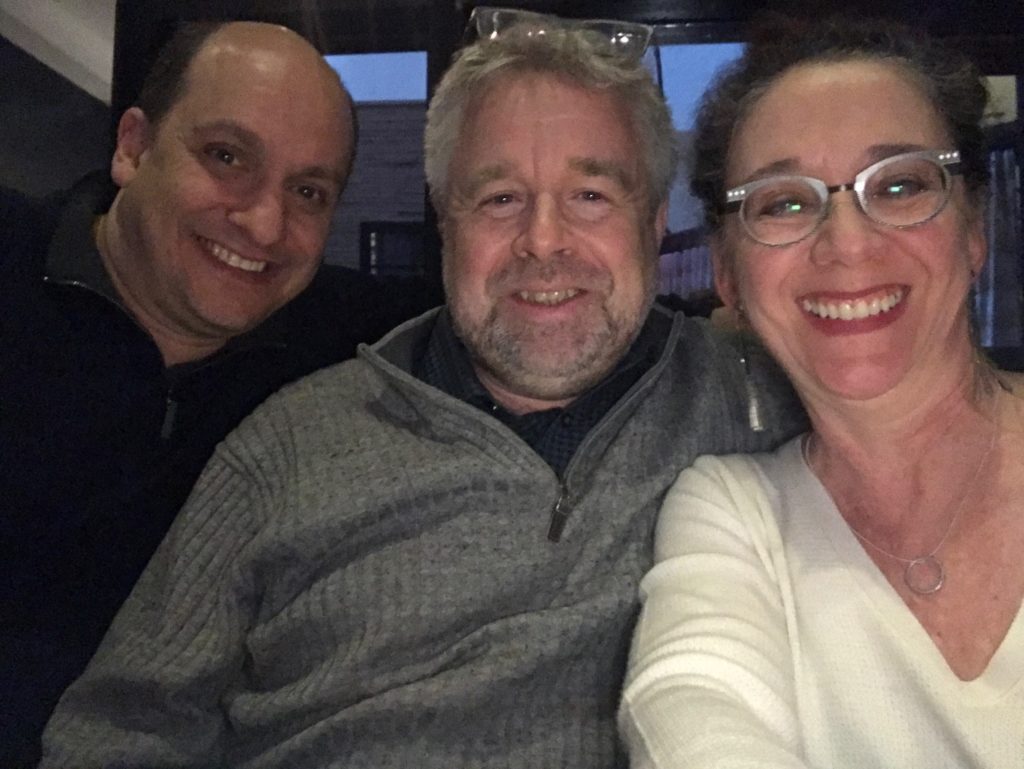As Creation In Common celebrates our 20th anniversary this year, we look back to the very beginning, when three theater makers — Dana Gillespie, Carlo Cuesta, and Padraic Lillis — came together to find our moonshot: our big idea to make a difference in the world.
PADRAIC: I met Carlo while working at the Berkshire Theatre Festival in the summer of 1990. After that we were both directing interns at Portland Stage in Maine. We lived together for a year, and then Carlo moved to Texas to escape the cold. That’s where he met Dana. Carlo and I remained good friends and I got to spend time with both of them when I was a guest artist at Carleton College in 1998.
To support my directing career I worked in-house at a Wall Street temporary staffing firm. I remember having conversations with Carlo right after he had completed a capital campaign for the Playwrights’ Center in Minneapolis, where he was executive director. He was interested in starting a new business, so we tossed around ideas about what makes a business effective.
CARLO: I always wanted to start a business. I just didn’t know what kind of business to start. I’d been thinking about it for a few years. I was at the Playwrights’ Center at the time, and Dana was at Pillsbury United Communities. We had each just finished major campaigns for our respective organizations. We escaped to my parents’ old summer home in upstate New York for a three-week vacation, which was a luxury.
DANA: We had no news. No TV for the full three weeks. One night we were sitting out under the stars and listening to the water on the river. And I looked at Carlo and said, I don’t want to go back. We were exhausted. We were happy it was all over. And we both felt we had gotten as far as we could with our current jobs. It was time for us to get out of the way and let those organizations continue to thrive without us.
CARLO: During the drive back home, with our daughter and our dog in the backseat, we spent 18 hours rewriting our lives together. We knew we wanted the core principles of the new business to be both collaborative and creative, but we weren’t sure what it should look like.
DANA: More than anything I hate applying for new jobs. So when we got back, we started really looking into it. Carlo is one of those extraordinarily planful people. I mean, he’s got charts and graphs and spreadsheets. He was diving in. At the time, I took more of a “let’s see what happens” kind of approach.
CARLO: So I decided to call Padraic.
PADRAIC: I think it was 2001. I flew up to the Twin Cities and the three of us sat around their kitchen table talking about what this new business could be. One original idea was to engage communities through theater and the arts.
DANA: It’s funny to think that I ever had a moonshot back then. When we started, my vision was a whole lot smaller. Our joke, whenever the three of us were talking, was they were 80,000 feet in the air and I was on the curb.
I was the practical one who always said, “Oh, that sounds really good. Now, how are we going to get there?” At one point, Padraic wanted to design the opening ceremony for the Olympics. They wanted to change the world tomorrow.
PADRAIC: Eventually, our talk turned to organizations. We were artists, writers, and directors, but we also had experience in communications, administration, fundraising, and workforce engagement. We all came from theater, but we also wanted to do something more than theater. We wanted to have a broader impact in the community.
I remember Carlo’s elevator pitch: We’re advisors to superheroes. When he said it, it resonated. We weren’t working for the food bank, but we could advise them on how to strengthen their impact and be as effective as possible.
CARLO: We kept flying Padraic in to spend a couple days with us to plan and brainstorm. And then something interesting happened. We had an early opportunity to do a management consulting project — creating a business plan for a daycare center for the organization Dana worked for. That job proved that we could apply the creative and collaborative principles that we had developed in our professional careers to the business arena.
And then all of a sudden, an RFP for a huge project came across my desk at the Playwrights’ Center. The Minnesota State Arts Board needed a team to train every arts leader in the state on how to build arts participation. And I thought, We could do that.
DANA: When we got the job with the Minnesota State Arts Board to do the Strategic Audience Development Initiative (SADI) training through the Wallace Foundation, we travelled across the state and met a lot of people. One of the first things we thought afterwards was, Hey, we need to take this show on the road nationally.
CARLO: In hindsight, it basically was like getting the opening ceremonies of the Olympics job, because it was a three-year project with a lot of money and resources behind it. It was a lot of work, and boy, did we have to learn on the job. It may not have been an intentional moonshot, but it was the moonshot at that time.
We were thrust into a huge, major project. We were given enormous responsibility to deliver. We made every mistake imaginable. But we learned so much. At the time a colleague said something really terrific: That job is going to inform every aspect of what you do in the future. They were right.
From SADI came an amazing research project that led to an award-winning book that we wrote on the impact of art on rural communities. That also led to another amazing project in Dallas, creating what is now Art and Seek, an award-winning journalism source for arts news and events.
Here’s the analogy I would make about our earliest beginnings. Remember how Kennedy made the speech about putting a man on the moon by the end of the decade? He admitted he didn’t know how we were going to get to the moon. We didn’t even have the technology. But he made the promise anyway, and then he had to figure out how to achieve that promise. That’s pretty much what we did.
PADRAIC: Looking back, I think one of the core strengths of Creation In Common for the past 20 years has been empathy. We could understand the emotion that people invest in the work they’re doing, while also being far enough removed from it to provide practical, logical solutions for effectively moving forward.
That’s why organizations should work with CIC today. Empathy makes for great partners, particularly in
these unique times to help guide in making decisions. The value of the past twenty years is what makes Creation In Common great partners for the next twenty. Especially now – while we’re reimagining the world as it can be.
My time at Creation In Common (Padraic left the company in 2011) absolutely informed my work as a director and as the artistic director of The Farm Theater in Brooklyn. It got me out into small communities across the country, where I found that great artists and commitment to art exist outside the big cultural centers of New York, Minneapolis, and Chicago. It filled that need to have an impact on my community and honed my skillset. I’d be a different artist today if not for Creation In Common.
CARLO: So now we’re considering our next moonshot. Over the past 10 years we’ve become part of the much larger field of capacity building. I served as a board member of a national organization that does this work, so I’ve gotten to know colleagues across the country who are capacity builders.
So far we’ve focused on organizational capacity building to advance impact. I feel like the next moonshot could be about human capability and how the capability of teams can advance impact.
DANA: I’m very impressed by people like José Andrés, the founder of World Central Kitchen, who see a problem and figure out how to fix it within a collaborative community. As a fundraiser, I have seen so much competition over the years between organizations and, sadly, even organizational leaders who scoff when another organization gets a bigger grant than they did.
The work we all do is good for the community, so why don’t we — as a community — come together to make that work bigger, stronger, and longer lasting? That’s the kind of work I would love to do more of and the kind of collaborative spirit I would love to see more of in the years to come. That’s a great moonshot for all of us.



